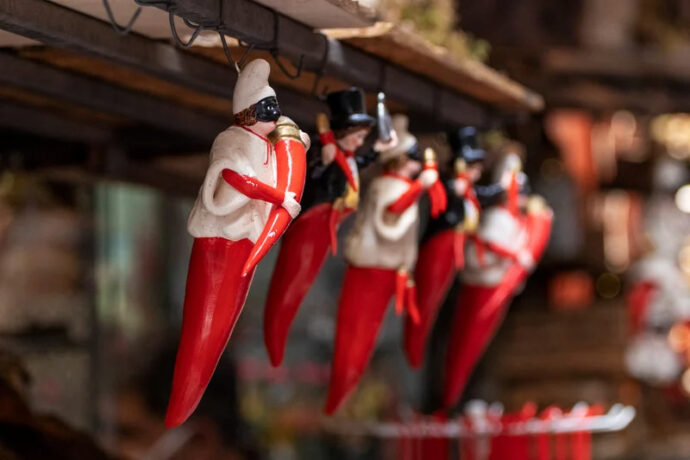When traveling to Naples, you will find red horn-shaped talisman charms called “cornicelli” hanging everywhere in the streets. They make for a great souvenir to remember your trip by, however it would be a shame to overlook the rich historic origins of this iconic charm. Since ancient times, people have believed in the power of using magic against evil. Amulets, talismans and other objects imbued with magical power have been used to ward off bad luck and to bring good fortune. In the city of Naples, you can find a special talisman called “corno” which in Italian means horn. A cornicello is a twisted horn-shaped amulet or charm which can be made of anything, including gold, silver, bone, or carved from red coral.
The color and shape of the red cornicelli look similar to chili pepper. Garlands of red chili peppers can be found hanging all over the streets of Naples, as a symbol of good luck. During the Middle Ages, the color red had a double meaning: it symbolized victory over enemies, including the Devil, and it symbolized good luck. In Naples, it is recognized as a symbol of good luck and protection. Artisans of old Naples began to craft a little horn with an odd shape; “tuosto, stuorto e cu a’ punta” which means, tough and twisted at the tip. Those who acquired such an amulet would be blessed with good luck.
History of the Cornicello
The use of the “corno” began around the Mediterranean during the Neolithic period, around 3500 B.C. This symbol was used by those ancient people as the bringer of good fortune as well as fertility. As a matter of fact, during that time, fertility was considered a blessing to the community. Likewise, the bull’s horns were also a symbol of male strength and virility. During ancient times, the horn was used as a votive offering to the Goddesses Venus and Luna. The red coral often used to make the charm is sacred to Venus, goddess of love, and silver is sacred to Luna, the goddess of the moon. The red color and phallic shape are also related to the male fertility god Priapus.
It’s believed that the evil eye can bring harm to nursing mothers and their babies, as well as damage fruit trees, milk animals, and male sperm. In other words, this evil brings harm to the forces of generation. In addition to being worn as a talisman or charm, the cornicelli are often hung from the rearview mirrors of trucks and cars. This is a modern take on the old custom of protecting draft horses with the cornicelli. Likewise, the symbol can also be found hung in doorways to protect homes and businesses.
Finding Cornicelli in Naples
Wherever you go in the city of Naples, you will see thousands of “cornicelli” of every shape and size. While the meaning of this ubiquitous talisman is often overlooked, they are emblematic of ancient Neapolitan superstition. The cornicelli reaches back over many centuries, demonstrating the persistent value of good health and family which is so fundamental in Italian culture.
One place you can certainly find these good luck charms is on San Gregorio Armeno Street; one of the most lively streets in Naples, lined with small shops selling “cornicello” charms of many variations. If you find yourself on this street, be sure to buy one of these unique charms as a gift for someone back home. A cornicello charm only brings good luck it is given to you, so don’t buy one for yourself, instead get one for a friend or family member at home!
